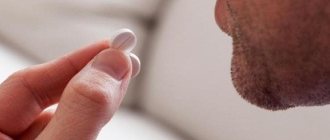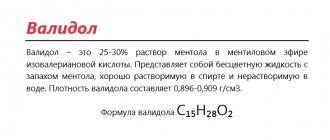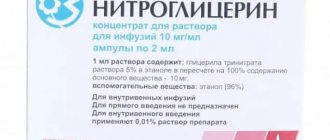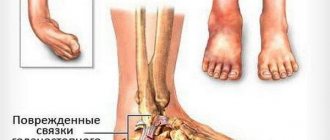Pharmacodynamics and pharmacokinetics
The drug has antiarrhythmic, antianginal, and hypotensive effects. It has negative dromotropic, chronotropic, inotropic and bathmotropic effects.
The hypotensive effect is achieved by influencing the nervous system, reducing the sensitivity of baroreceptors on the aortic arch, reducing the activity of the renin-angiotensin system , and reducing the IOC.
The drug reduces systolic and diastolic blood pressure, reduces IOC, SV.
The medication does not affect the tone of peripheral arteries in therapeutic doses.
The antianginal effect is ensured by a decrease in the oxygen demand of myocardial cardiomyocytes, which leads to a decrease in heart rate. The drug reduces heart rate at rest and during physical activity.
The antiarrhythmic effect is ensured by the elimination of arrhythmogenic factors (arterial hypertension, increased cAMP content, increased activity of the sympathetic nervous system, tachycardia), slowing down atrioventricular conduction , and reducing the rate of spontaneous excitation of the ectopic and sinus pacemaker.
When taking Atenolol, the survival rate of patients who have suffered a myocardial infarction increases significantly.
The drug does not weaken the bronchodilatory effect of isoproterenol.
Pharmacodynamics
Action typical of beta blockers.
Atenolol acts selectively, not on the entire body, but in a targeted manner: cardioselectively. Its purpose: to influence the heart and the coronary vessels that feed it, to help the circulatory system of the heart cope with the load. Or relieve, or more often – prevent – an attack of angina pectoris. Taking atenolol on the first day reduces cardiac output. Peripheral vessels react to this reflexively, their resistance increases. The effect is not curative, but not catastrophic. With continued use, the condition of the blood vessels becomes the same within 24, maximum 72, hours.
Further treatment with atenolol reduces this resistance even compared to the former before the first dose. This reduces blood pressure (antihypertensive effect) and evens out the rhythm in those suffering from arrhythmia.
The medicine also has an antianginal effect - relieving ischemic symptoms (pain, shortness of breath). Atenolol does not have analgesic properties. The pain goes away because its cause is eliminated. This is an important point. It’s not just that the symptom is stopped, the healing process occurs.
The myocardial conduction system receives a smaller excitation signal. This suppresses tachycardia and various types of extrasystoles. The heart rate slows down, the rhythm of contractions evens out. The heart rate after taking atenolol does not decrease sharply, within about an hour. An abrupt change, the transition from tachycardia to almost bradycardia, is dangerous for the myocardium. The drug works - gently, this is also a plus.
As a result, the heart is protected, it does not experience oxygen starvation, there is no overload. Dangerous types of arrhythmias are blocked. The patient's condition is normalized and stabilized.
The action of atenolol specifically affects beta1-adrenergic receptors. There are also beta2-adrenergic receptors in the body.
They regulate the work:
- Skeletal muscles;
- Vascular walls of the arteries of the bronchi, uterus;
- Pancreas.
Beta2-adrenergic receptors control metabolic processes (carbohydrate metabolism).
Atenolol in the doses recommended in the instructions for use and prescribed by the doctor does not interfere with the functioning of type 2 adrenergic receptors. Exceeding the dosage can block these receptors, so the maximum is 100 mg, and you should not take more.
Indications for use of Atenolol
What are the pills for?
The medicine is prescribed for hypertensive crisis , arterial hypertension, angina pectoris, ischemic heart disease, neurocirculatory dystonia , hyperkinetic cardiac syndrome of functional origin, withdrawal syndrome, tremor, essential tremor, agitation.
The drug is recommended for use for the prevention of rhythm disturbances, myocardial infarction, ventricular extrasystole , sinus tachycardia, atrial flutter, atrial fibrillation, and ventricular tachycardia.
The medication is prescribed for migraine, thyrotoxicosis, pheochromocytoma .
Indications for use of Atenolol Nycomed are similar.
Atenolol tablets
Atenolol belongs to the pharmacological group of beta-blockers. It blocks specific adrenergic receptors in blood vessels and the heart, due to which the mechanism of action of the drug is realized and therapeutic effects are manifested:
- Antihypertensive effect - lowering blood pressure by reducing the effect of adrenaline (adrenal medulla hormone) and other catecholamines on arterial vessels and the heart.
- Antianginal effect - reducing the frequency of heart contractions, thereby reducing the myocardium's need for nutrients and oxygen.
- Antiarrhythmic effect - by stabilizing the membranes of neurocytes and reducing the excitability of cardiac myocardial cells, the medication helps to normalize the rhythm of contractions.
Normalization of the functional state of the heart and blood vessels does not begin immediately after starting to take the medicine, but within 2 weeks. Immediately after taking the first tablet, a temporary increase in blood pressure is possible, which is of reactive origin.
The drug Atenolol can always be bought at a pharmacy if you have a prescription from your doctor. The tablets have a hypotensive, antiarrhythmic and antianginal effect on a group of certain diseases with the help of a beta-blocker. Systolic arterial (blood) pressure creates pressure in the arteries. At the same time, the heart contracts and pushes blood out of the stomachs, which makes the person feel unwell.
Compound
One tablet of the drug contains the main substance (atenolol) with a volume of 25-50 or 100 mg, they are available in white or cream color with a slight “marbling”. The composition includes auxiliary components such as:
- corn starch;
- magnesium stearate;
- calcium hydrogen phosphate;
- talc;
- sodium carboxymethyl starch;
- colloidal silicon dioxide;
- methyl parahydroxybenzoate.
Release form
The drug is sold in a cardboard pack containing from 1 to 10 blisters. In total, the package includes 10, 14 or 20 tablets. The weight of the tablet can vary from 25, 50 to 100 mg. The blisters are made of aluminum, and the blister packs contain 10 tablets. There can be 3 or 5 of them. 100 mg tablets are available for purchase, which are packaged in blisters - 3 or 5 pieces of 10 tablets each. May be sold in ampoules for intravenous use.
Mechanism of action
Atenolol is a kind of blockade of nerve impulses that regulate heart contractions and helps reduce blood pressure with the help of catecholamine. It also reduces the heart rate during rest and during exercise. With its help, atrioventricular conduction slows down and myocardial excitability decreases.
The drug is prescribed by a doctor for arterial hypertension, for the prevention of angina attacks (except for Prinzmetal's angina), and for heart rate disorders (heart rate). This includes diseases such as sinus tachycardia, thyrotoxicosis, ventricular extrasystole and supraventricular tachyarrhythmia. It also helps with:
- coronary heart disease;
- during hypertensive crisis;
- hyperkinetic cardiac syndrome.
Contraindications
The drug is contraindicated in many diseases, such as cardiogenic shock, atrioventricular block, sick sinus syndrome, bradycardia, acute chronic heart failure, arterial hypotension, during lactation, cardiomegaly (without signs of HF - heart failure).
- diabetes;
- hypoglycemia;
- emphysema;
- Raynaud's syndrome;
- there is a history of an allergic reaction;
- acidosis (metabolic);
- depression;
- psoriasis;
- myasthenia gravis;
- elderly age;
- pregnancy.
Contraindications
The medicine is not used for severe bradycardia, 2-3 degree atrioventricular block, cardiogenic shock , decompensated form of CHF, acute heart failure, SA blockade, Prinzmetal angina , intolerance to the active component, cardiomegaly, breastfeeding, taking MAO inhibitors.
For pulmonary emphysema, allergies, metabolic acidosis, diabetes mellitus, hypoglycemia, pheochromocytoma, bronchial asthma, thyrotoxicosis, myasthenia gravis, liver failure , pregnancy, psoriasis, depression, children and the elderly, and Raynaud's syndrome, the drug is used with caution.
Contraindications to taking Atenolol
Medical experts identify the following contraindications to the use of Atenolol tablets for blood pressure:
- Severe heart failure;
- Individual intolerance and hypersensitivity to the active ingredients of the drug;
- Acidosis;
- Shock conditions;
- Violation of circulatory processes, occurring in an acute form;
- Slow heart rate (bradycardia);
- Reduced blood pressure (hypotonic disease);
- Bronchial asthma;
- Impaired perfusion of the upper and lower extremities, occurring in the final stages;
- Increased tendency to allergic reactions;
- Sinoatrial block;
- Raynaud's syndrome;
- Childhood age of the patient.
This drug is prescribed with great caution if you are prone to hypotension (Atenolol lowers blood pressure), following a strict diet, or have recently undergone surgical interventions using anesthesia.
Side effects
Sense organs: conjunctivitis , visual disturbances, dry eyes, decreased tear production, sore eyes.
Nervous system: depression, insomnia, headaches, dizziness, weakness, asthenia, drowsiness, depression, paresthesia in the extremities , impaired concentration, short-term memory loss, convulsions, myasthenia gravis.
Cardiovascular system: chest pain, vasculitis, coldness of the lower extremities, vasospasm, orthostatic hypotension, CHF, weakened myocardial contractility, arrhythmia, atrioventricular block, palpitations, bradycardia, myocardial conduction disturbances.
Digestive system: changes in taste perception, epigastric pain, nausea, vomiting, dry mouth, stool disorders: constipation , diarrhea.
Respiratory system: bronchospasm, laryngospasm , difficulty breathing, nasal congestion.
Endocrine system: hypothyroid state, hyperglycemia, hypoglycemia.
Skin: reversible alopecia, psoriasis-like skin rashes, increased sweating, exacerbation of psoriasis symptoms, skin hyperemia.
Also noted are back pain, bradycardia , decreased potency, decreased libido, arthralgia, and intrauterine growth retardation.
The severity of side effects directly depends on the dose of the drug.
Side effects of the drug Atenolol
Most side effects are mild and temporary. Most likely are bradycardia, a feeling of coldness in the extremities, paresthesia, pain in the lower extremities, nausea, increased concentrations of liver enzymes and/or bilirubin in the blood serum, dizziness, headache, orthostatic hypotension, collapse, fatigue, weakness, drowsiness, general malaise, depression, hallucinations, psychosis, diarrhea, nausea, dyspnea, psoriasiform rash or exacerbation of psoriasis, purpura, reversible alopecia, thrombocytopenia and visual disturbances. Atenolol, like other β-adrenergic receptor blockers, can promote the formation of antinuclear antibodies and the development of lupus syndrome.
Instructions for use of Atenolol (Method and dosage)
The tablets are taken orally, washed down with liquid, and do not chew.
The initial dosage is 25-50 mg per day, after a week, if necessary, the amount of the drug is increased by 50 mg, the average daily dosage is 100 mg.
For tachysystolic disorders and for ischemic heart disease, Atenolol is prescribed once a day, 50 mg.
Acute myocardial infarction with stable hemodynamic parameters: intravenous infusions, then take a 50 mg tablet after 10 minutes, repeat after 12 hours.
For cardiac hyperkinetic syndrome, 25 mg per day is indicated.
The drug is effective for 24 hours; the drug is not used more than once a day. It is not recommended to prescribe more than 200 mg per day. The medication is withdrawn gradually, every 3 days - ¼ dose.
Instructions for use of Atenolol Nycomed are similar.
Composition, release form and manufacturer
The drug Atenolol is presented on the pharmaceutical market in an easy-to-use tablet form. The manufacturer of this medication is Croatian.
The tablets contain:
- Atenolol is the main active ingredient of the drug.
- Auxiliary ingredients (magnesium stearate, starch, silicon dioxide, lactose monohydrate).
At the pharmacy you can purchase the medicine Atenolol in the following dosages of the main active ingredient:
- 25 mg;
- 50 mg;
- 100 mg.
The drug is sold in packages of 20, 50 or 100 tablets.
Atenolol is a drug used in the treatment of hypertension
Overdose
Manifested by bronchospasm , cyanosis of the nail plates, convulsions , difficulty breathing, arrhythmia, fainting, drop in blood pressure, dizziness, severe bradycardia.
Emergency gastric lavage is required.
In case of atrioventricular conduction disturbance or bradycardia, atropine, epinephrine is administered intravenously, or a temporary pacemaker is installed.
If there is a sharp drop in blood pressure, the patient is placed in the Trendelenburg position .
In the absence of signs of pulmonary edema, plasma-substituting solutions are administered intravenously; in case of ineffectiveness, dobutamine , epinephrine, and dopamine are administered.
For convulsive syndrome, intravenous infusion of diazepam is indicated. Dialysis is effective.
Overdose of the drug Atenolol, symptoms and treatment
An overdose of atenolol has been described in patients who took a single dose of about 5 g. Early manifestations of an overdose are drowsiness, respiratory failure, wheezing, and bradycardia. Congestive heart failure, arterial hypotension, bronchospasm and hypoglycemia may develop. Gastric lavage is performed, activated charcoal is prescribed orally, and glucagon is administered. Atenolol can be removed from the systemic circulation by hemodialysis. For bradycardia or AV block, atropine or isoproterenol is administered; if drug treatment is ineffective, transesophageal pacing is performed. For congestive heart failure, digitalization is performed and diuretics are prescribed.
List of pharmacies where you can buy Atenolol:
- Moscow
- Saint Petersburg
Interaction
In patients taking Atenolol, allergen extracts for skin testing, as well as allergens for immunotherapy, significantly increase the risk of developing severe systemic allergic reactions, anaphylaxis. The risk of anaphylactic reactions increases with intravenous administration of radiocontrast agents.
A fall in blood pressure and cardiodepressive effects have been observed with intravenous infusion of phenytoin, as well as with the use of drugs for inhaled general anesthesia. The drug can mask the signs of developing hypoglycemia with the simultaneous use of oral hypoglycemic agents and insulin.
Atenolol reduces the clearance of xanthines and lidocaine . Estrogens, glucocorticosteroids, NSAIDs, BMCC, guanfacine, reserpine, methyldopa , cardiac glycosides, amiodarone, Diltiazem , Verapamil and many antiarrhythmic medications increase the likelihood of developing atrioventricular block, bradycardia, cardiac arrest, and worsening heart failure.
Hydralazine, sympatholytics, clonidine, diuretics, antihypertensive drugs, BMCC can significantly reduce blood pressure.
Atenolol prolongs the duration of action of coumarins, non-depolarizing muscle relaxants. Neuroleptics, sedatives, hypnotics, ethanol, tetracyclic and tricyclic antidepressants increase the inhibitory effect on the central nervous system.
The simultaneous administration of MAO inhibitors is unacceptable due to the risk of hypotension. Impaired peripheral circulation is observed when using medications with non-hydrogenated ergot alkaloids.
When is the drug used?
There are certain medical indications for taking Atenolol tablets that are associated with disruption of the heart and blood vessels, these include:
- Arrhythmias (disturbances in the rhythm of heart contractions) of various origins.
- Arterial hypertension, characterized by a prolonged increase in blood pressure.
- Ventricular extrasystole is one of the variants of arrhythmia, in which extraordinary contractions of the heart develop, associated with the formation of an impulse in the conduction system of the ventricles.
- Sinus tachycardia with increased heart rate.
- Angina pectoris, attacks of which are compressive pains that appear due to insufficient supply of oxygen and nutritional compounds to the myocardium. The medication is used for prevention.
Also, the drug can be prescribed to prevent infarction (death of a section of the heart muscle resulting from a sharp and pronounced decrease in blood supply) to the myocardium and increased heart contractions that are of supraventricular origin.
Important! Medical indications for taking Atenolol tablets can only be determined by a general practitioner or cardiologist.
special instructions
Taking the drug should be accompanied by regular measurement of blood pressure, pulse, and sugar levels in people with diabetes .
Elderly patients are advised to periodically monitor the condition of the renal system. The doctor needs to instruct the patient and teach him how to measure heart rate correctly. In 20% of patients with angina, adrenergic blockers do not provide the desired effect due to severe coronary atherosclerosis with a low ischemic threshold and impaired subendocardial blood flow .
In patients with nicotine addiction, the effectiveness of Atenolol is significantly lower than in patients who do not smoke. During therapy, there may be a decrease in the production of tear fluid, which should be warned about in patients who wear contact lenses.
The drug may mask the clinical picture of thyrotoxicosis (tachycardia). Abrupt withdrawal of the drug in patients with thyrotoxicosis is unacceptable due to the risk of increasing the severity of the symptoms of the disease. Atenolol is able to mask tachycardia during hypoglycemia. The medication is discontinued several days before the planned general anesthesia with ether or chloroform. Otherwise, the patient is selected a drug for general anesthesia, which has minimal inotropic effects.
Intravenous administration of atropine eliminates reciprocal activation of the vagus nerve. The drug can be prescribed to patients with bronchospastic pathology if other antihypertensive drugs are ineffective or intolerant, subject to strict adherence to the dosage regimen.
If elderly people develop arterial hypotension, increasing bradycardia, ventricular arrhythmia, bronchospasm, severe disorders of the liver and kidneys, the dosage of the drug is reduced or therapy is stopped completely. If depression develops, the drug is replaced. Abrupt withdrawal can cause myocardial infarction, a severe form of arrhythmia. The drug is discontinued by gradually reducing the dosage over two weeks.
Before determining the level of normetanephrine, catecholamines, antinuclear body titers, and vanillylmandelic acid, Atenolol is discontinued. The medication affects the control of vehicles.
Recipe in Latin:
Rp: Atenololi 0.05 D. td N 30 in tab. S. 1 tablet 1 time per day.
Pharmacokinetics
The drug is absorbed quickly from the gastrointestinal tract, but not completely; approximately half of the active substance enters the bloodstream. If circumstances require quick action, the tablet is placed under the tongue. There, the mucous membrane has many vessels, and the drug directly enters through them - into the bloodstream.
Traditionally, the use of atenolol is indicated - orally. The sublingual (sublingual) method is only for emergency conditions when other drugs are unavailable for some reason.
When administered orally (internally, through the mouth), the desired (maximum) concentration of the drug is reached in the blood within two hours of administration. Blood proteins partially, up to 15%, bind the active substance. The liver is not involved in the metabolism of atenolol. It is excreted by the kidneys. The drug has already done the necessary work in the body, and up to 100% (sometimes less - up to 85%) is excreted in the same, unchanged form.
After oral administration, atenolol is rapidly absorbed from the gastrointestinal tract - approximately 50% of the dose taken orally. Solubility in fats is poor, bioavailability is 40-50%, Tmax in blood plasma after oral administration is 2-4 hours.
It penetrates poorly through the blood-brain barrier and passes in small quantities through the placental barrier and into breast milk. Binding to blood plasma proteins is 6-16%. Practically not metabolized in the liver.
T1/2 - 6-9 hours (increases in elderly patients). Excreted by the kidneys by glomerular filtration (85-100% unchanged).
Impaired renal function is accompanied by prolongation and cumulation: with creatinine clearance below 35 mg/min/1.73 m2, T1/2 is 16-27 hours, with clearance below 15 mg/min - more than 27 hours (dosage reduction is necessary).
Excreted during hemodialysis.
Atenolol's analogs
Level 4 ATC code matches:
Biol
Metocard
Metozok
Nebilet
Nebilong
Betaxolol
Bisogamma
Aritel
Cordinorm
Vasocardin
Corvitol
Bidop
Bisoprolol
Nebivolol
Biprol
Bisoprol
Concor Cor
Lokren
Concor
Niperten
Analogues of Atenolol are the following products: Atenobene , Atenova , Atenol , Tenolol.
Peculiarities
Before prescribing a medicine, a medical specialist studies the annotation for it. There are several features of using the drug, which include:
- It is important to study the compatibility of the drug with medications from other groups.
- Simultaneous intake of alcohol is excluded. Against the background of alcohol intoxication, especially with a hangover, the development of negative reactions from the heart is possible.
- Drug analogues (Bisoprolol) have a similar therapeutic effect. You can cancel Atenolol and switch to other drugs only after appropriate doctor’s advice.
- If negative reactions occur, it may be necessary to discontinue the medication or replace it with similar drugs.
- The performance of work related to the need for increased reaction speed is excluded.
Atenolol belongs to the prescription group of drugs, so it is dispensed in pharmacies with a doctor's prescription.
Reviews of Atenolol
The drug is effective for hypertension and arrhythmia, and is quite inexpensive. However, side effects are common, such as hallucinations and a decrease in blood sugar. Reviews of Atenolol Nycomed are generally better than those of drugs produced by other manufacturers.
Reviews during pregnancy are generally positive; those who used the medication mostly did not notice any side effects. However, it should be remembered that according to the results of clinical studies, such side effects on the fetus are very possible.
When not to use
The drug Atenolol is not prescribed for certain pathological or physiological conditions of the patient’s body, which include:
- Blockade of the nerve node located between the atria and ventricles (atrioventricular node).
- Syndrome of insufficient functional activity (weakness) of the heart pacemaker.
- Heart failure with severe impairment of contractility (decompensation).
- Benign hormone-producing tumor of the adrenal medulla (pheochromocytoma).
- A marked decrease in blood pressure, especially against the background of a myocardial infarction.
- Marked decrease in heart rate (bradycardia).
- Enlarged heart (cardiomegaly) without signs of heart failure.
- Severe bronchial asthma.
- The patient is under 18 years of age - the medication is not prescribed to children and adolescents.
- Pregnancy and lactation (breastfeeding) in women.
- Individual intolerance to any of the components of the tablets.
Before making a prescription, the attending medical specialist must make sure that the patient has no contraindications.
Atenolol tablets are intended for parenteral use. They are taken before meals, without chewing and with plenty of water. The dosage of the main active ingredient varies from 25 to 100 mg once a day, which depends on the pathological process that became the indication for prescribing the drug.
The selection of the dose, determination of the regimen and duration of use of the medicine is carried out by the attending physician on an individual basis based on the results of the diagnostic objective examination.
Atenolol price, where to buy
Price Atenolol 25 mg, 30 tablets - 17 rubles.
50 mg, 30 pieces - 21 rubles.
- Online pharmacies in RussiaRussia
- Online pharmacies in UkraineUkraine
- Online pharmacies in KazakhstanKazakhstan
ZdravCity
- Atenolol tablets 100 mg 30 pcs. AO Update PFK
39 rub. order - Atenolol tablets 50 mg 30 pcs. AO Update PFC
39 RUR order
- Atenolol tab. 50mg n30Pliva
58 RUR order
Pharmacy Dialogue
- Atenolol tablets 50 mg No. 30Ozon LLC
23 RUR order
- Atenolol tablets 100 mg No. 30Update PFK ZAO
44 RUR order
- Atenolol tablets 50 mg No. 30Update PFK ZAO
47 RUR order
show more
Pharmacy24
- Atenolol-Zdorovye 0.05 g No. 20 tablets TOV" Pharmaceutical company "Zdorovya", Kharkiv, Ukraine
9 UAH. order - Atenolol-Astrapharm 50 mg No. 20 tablets TOV Astrapharm, Ukraine
7 UAH order
- Atenolol-Astrapharm 100 mg No. 20 tablets TOV Astrapharm, Ukraine
11 UAH order
- Atenolol 50 mg No. 20 tablets PAT Monpharm, Ukraine
8 UAH order
PaniPharmacy
- ATENOLOL tablets Atenolol tablets 50 mg No. 20 Ukraine, Astrapharm LLC
8 UAH order
- ATENOLOL tablets Atenolol tablets 100 mg No. 20 Ukraine, Astrapharm LLC
12 UAH order
- ATENOLOL tablets Atenolol tablets 50 mg No. 20 Ukraine, Monfarm JSC
9 UAH order
- ATENOLOL tablets Atenolol tablets 50 mg No. 20 Ukraine, Health LLC
11 UAH order
show more








